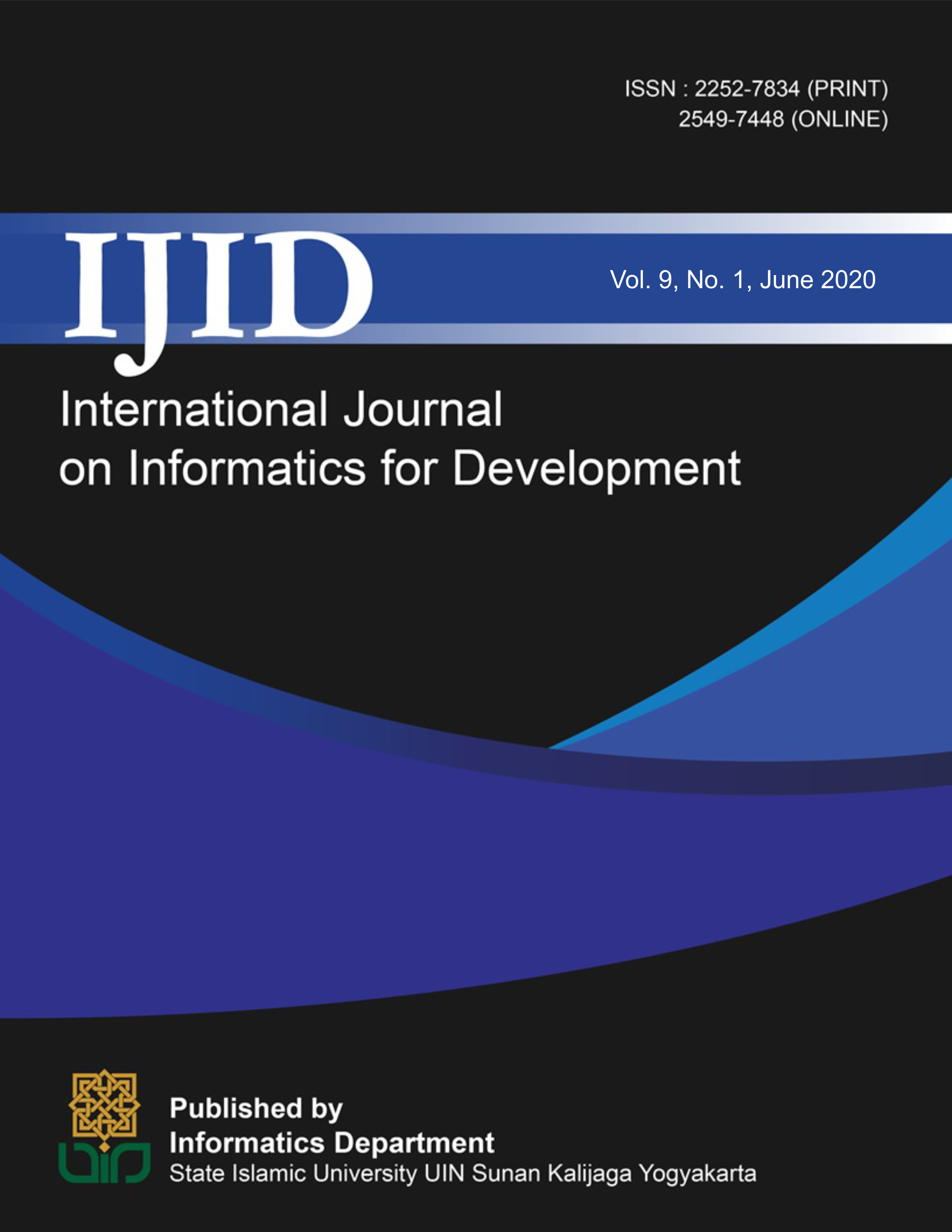Abstract
Controversies about veil and hijab are often occur in society. Especially in today’s digital era, public opinion expressed through social media can greatly influence the others opinions, regardless of whether it is positive or negative. Therefore, this research was aiming to conduct an approach through analysis sentiment of public opinion about the veil and hijab to know how much accurate the sentiment analysis predict the positive, negative, or other sentiments with using Twitter data as the research object. The algorithm used in this study is Support Vector Machine (SVM) because of its fairly good classification model though it trained using small set of data. The SVM on this research was combined with Radial Base Function (RBF) kernel because of its numerical difficulties that are fewer than linear and polynomial kernel and also because this research doesn’t have a large feature. The amount of data used is 3556 tweets data. Tweets data, which is numbered 1056, is classified manually for the learning process. The remaining 2500 data will be classified automatically with the classifier model that has been created. A total of 1056 tweets data that have been classified manually is separated into training and testing data with a ratio of 8: 2. The result of the sentiment analysis process using Support Vector Machine algorithm RBF kernel with C=1 and γ=1 has an accuracy score of 73.6% with precision to negative opinions are 62%, positive opinions are 83%, neutral opinions reach 53% and irrelevant opinions that talk about hijab and veil reach 98%. It shows that sentiment analysis can be used for predicting the negative, positive or other sentiments of a sentence based on a certain topic, in this case veil and hijab.
References
H. Maulana, “Media Sosial sebagai Sumber keberagamaan Alternatif Remaja dalam Fenomena Cyberreligion,” Dakwah J. Kaji. Dakwah dan Kemasyarakatan, vol. 22, no. 1, pp. 1–34, 2018, doi: http://doi.org/10.15408/dakwah.v22i1.12044.
B. A. Sevsa and M. D. R Wahyudi, “Analisis Sentimen pada Indeks Kinerja Dosen Fakultas SAINTEK UIN Sunan Kalijaga Menggunakan Naive Bayes Classifier,” J. Buana Inform., vol. 10, no. 2, p. 112, 2019, doi: 10.24002/jbi.v10i2.2250.
P. A. R. Dewi, “NIQAB SEBAGAI FASHION: DIALEKTIK KONSERVATISME DAN BUDAYA POPULER,” Scriptura, vol. 9, no. 1, pp. 9–15, Aug. 2019, doi: 10.9744/scriptura.9.1.9-15.
L. Rasyid and R. Bukido, “PROBLEMTIKA HUKUM CADAR DALAMISLAM: SEBUAH TINJAUAN NORMATIF-HISTORIS,” J. Ilm. Al-Syir’ah, vol. 16, no. 1, pp. 74–92, 2018, Accessed: Aug. 12, 2020. [Online]. Available: https://www.researchgate.net/publication/326805010_PROBLEMTIKA_HUKUM_CADAR_DALAMISLAM_SEBUAH_TINJAUAN_NORMATIF-HISTORIS.
W. Nuroniyah, “DEKONSTRUKSI HIJAB,” Al-Manahij, vol. 11, no. 2, pp. 263–280, Dec. 2017, doi: 10.24090/mnh.v11i2.2017.pp263-280.
M. Mujahidin, “Veil: Antara Ajaran Agama dan Budaya,” JUSPI (Jurnal Sej. Perad. Islam., vol. 3, no. 1, p. 11, Jul. 2019, doi: 10.30829/juspi.v3i1.3142.
B. Liu, Sentiment Analysis(Introduction and Survey) and Opinion Mining. 2012.
E. Prasetyo, Data Mining Konsep dan Aplikasi Menggunakan Matlab. ANDI Publisher, 2012.
S. R. Kao, Anne, Poteet, Natural Language Processing and Text Mining. New York: Springer-Verlag, Inc., 2007.
G. A. Buntoro, “Analisis Sentimen Calon Gubernur DKI Jakarta 2017 Di Twitter,” Integer J. Maret, vol. 1, no. 1, pp. 32–41, 2017.
A. Novantirani, M. K. Sabariah, and V. Effendy, “Analisis Sentimen pada Twitter untuk Mengenai Penggunaan Transportasi Umum Darat Dalam Kota dengan Metode Support Vector Machine,” e-Proceeeding Eng., vol. 2, no. 1, pp. 1–7, 2015.
M. D. R. Wahyudi, “Analisis sentimen ujaran kebencian pemilihan presiden 2019 menggunakan algoritma Naïve Bayes,” Jnanaloka (Jurnal Open Access Yayasan Lentera Dua Indonesia, no. 2020, pp. 5–10, 2020.
A. F. Hidayatullah, “Pengaruh Stopword Terhadap Performa Klasifikasi Tweet Berbahasa Indonesia,” JISKA (Jurnal Inform. Sunan Kalijaga), vol. 1, no. 1, pp. 1–4, 2016.
M. D. R. Wahyudi, “Evaluation of TF-IDF Algorithm Weighting Scheme in The Qur ’ an Translation Clustering with K-Means Algorithm,” 2020.
V. Apostolidis-afentoulis, “SVM Classification with Linear and RBF kernels Konstantina-Ina Lioufi,” ResearchGate, no. July, pp. 0–7, 2015, doi: 10.13140/RG.2.1.3351.4083.

IJID (International Journal on Informatics for Development) is licensed under a Creative Commons Attribution-NonCommercial-NoDerivatives 4.0 International License
